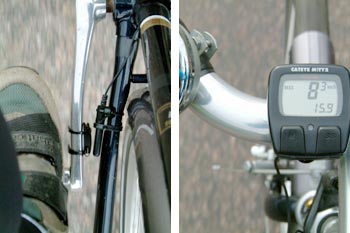[ 63XC.COM | HOW TO | CADENCE ]
Cadence computer
Would you like to know how fast you spin the pedals? This article tells you how to adapt a basic cycle computer to provide a cadence readout. I stopped using a cycle computer years ago. The urge to chase some target average speed had taken the enjoyment out of my leisure riding. These days, however, riding fixed, I thought it would be fun to put a figure on spin. I wondered if I could reuse my idle cycle computer for the job. A search on the web showed me that this idea was not new. I quickly found instructions on adapting the sensor setup. They were straightforward enough. I was less impressed by the explanations I Googled up on getting a cadence readout from the computer, so I spent some time making the figures add up. I'll take you through my reasoning later. But first, let's sort out that sensor... The sensor To get your cadence computer up and running, you'll need to mount your computer's sensor on the chainstay. This presents an obstacle: your sensor wire probably won't reach far enough. If you put your own bikes together, inserting an extra length of electrical flex shouldn't really be a problem. In my case, I soldered the connections. I chose to hide one join in the top tube, running the flex through the vacant internal rear brake cable run. I then fixed my sensor magnet to the back of the crank arm. Voila! The sensor now sends a signal to the computer each time my crank arm goes by. Done? Well, nearly... The calculations You've adapted your sensor to relay cadence information but the computer is designed to take input from a wheel. You still have to give the computer a cadence function that basic models don't have built in. Your best bet will be to use the computer's kph readout. After all, there is a simple relationship between cadence and speed. To adapt your computer's speed function, you first need to understand how it works normally. The computer's road speed calculation is a three step process. 1. You tell it the circumference of your wheel The speed formula really is simple. It can be expressed thus: (circ x rpm x 60)/100,000 = kph where: The computer multiplies the circumference of the wheel by the measured rpm to get the distance the bike travels in a minute, then again by 60 to get the distance covered in an hour, then divides the result by 100,000 to convert the original centimeter figures to their kilometer equivalent. Note that most computers allow you to program in your wheel circumference. That enables the same computer to accommodate many different tyre sizes. Here comes the thinking part. The circumference is an arbitrary number, and the rest of the speed formula is fixed. If you enter the right arbitrary wheel size, you can persuade your computer to display what it thinks is a roadspeed, when really it's your cadence. You might spot a problem here. My cadence goes well above 100 on downhills but my Cateye Mity 2 displays speeds only up to 99.9kph. There are three digits available but only two before the decimal point. Likely your computer is the same. That presents an obvious solution. Set up the computer so that it reads out at 1/10 and multiply the displayed figure by 10 in your head. That way, if your computer reads '11.2kph', you'll know that your cadence is 112rpm. This is easy to achieve. All you have to do is figure the appropriate circumference. More formally, you need to calculate the circumference of that wheel which, when spun at 10 rpm, will travel at 1kph. You can work it out by putting these values into the formula we used earlier. (circ x rpm x 60)/100,000 = kph (circ x 10 x 60)/100,000 = 1 circ = 100,000/(10 x 60) circ = 166.67cm This is good news. That circumference, rounded up to 167, falls nicely within the range of real tyre sizes accepted by my computer, and likely by yours also. If you reposition your sensor as above and then reprogram your computer with this new wheel circumference of 167cm, the kph readout will be one tenth of your true cadence. You can do the same thing with an mph readout if you prefer, but I will leave the maths to you... [ TOP ] |
Writer
Martin King is a cyclist rejuvenated by going fixed.
Date
v1.0 written February 2007
Related
Martin wrote for us about cycling London's towpaths.
Mailing list
Join the 63xc.com list.
